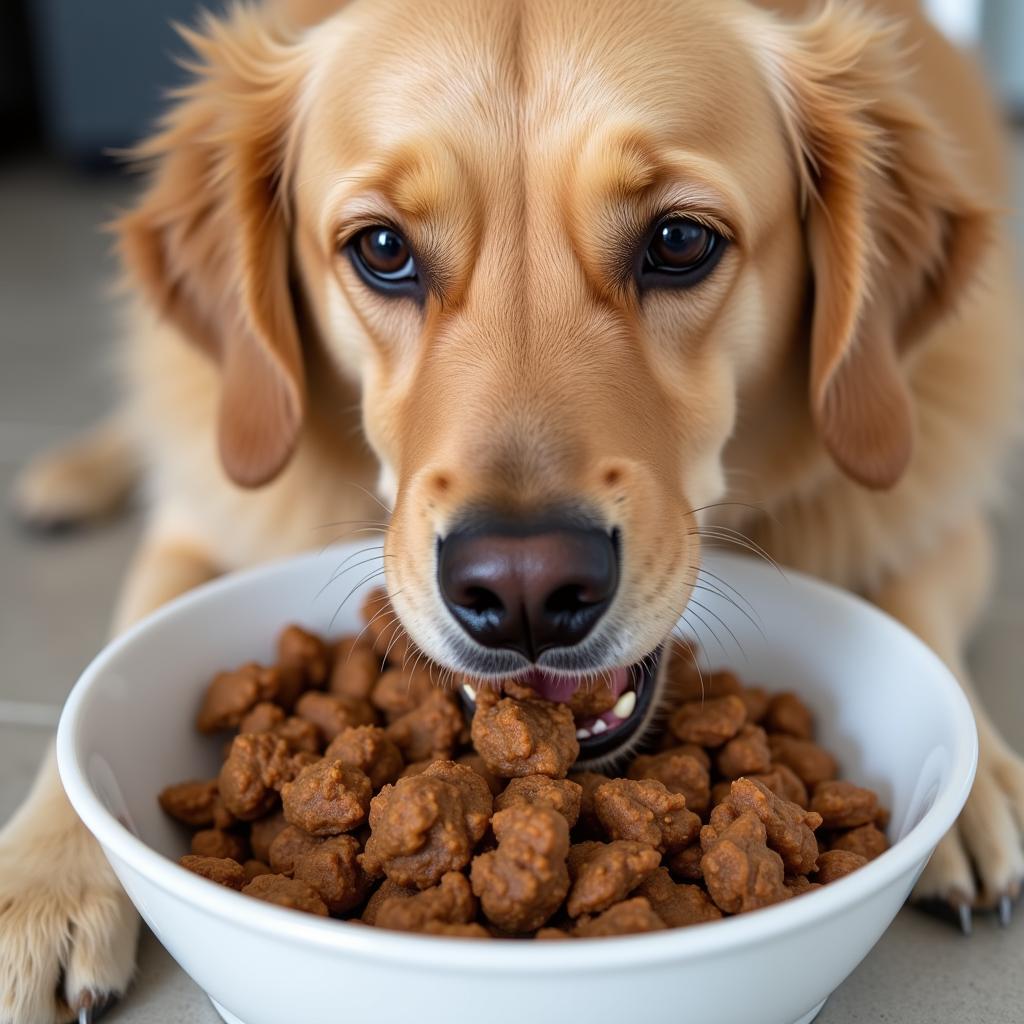Finding the right Dog Food For No Teeth can be a challenge, but with a little research and patience, you can ensure your furry friend enjoys mealtimes again. This guide will explore the best options for dogs missing teeth, addressing their specific nutritional needs and offering tips for making mealtimes as comfortable and enjoyable as possible.
For senior dogs or those who have lost teeth due to injury or illness, adjusting their diet is crucial. Proper nutrition supports their overall health and prevents further dental issues. Switching to soft food for dogs with no teeth can significantly improve their quality of life.
Choosing the Right Dog Food for Dogs Without Teeth
Several factors come into play when choosing dog food for dogs with no teeth. Consider the following:
- Texture: Opt for soft, wet foods, or specially formulated kibble that can be easily mashed or soaked in water or broth. Avoid hard, crunchy kibble as it can be painful and difficult to chew.
- Nutritional Value: Choose a complete and balanced diet that meets your dog’s age, breed, and health requirements. Look for foods rich in protein, healthy fats, and essential vitamins and minerals.
- Ingredients: Select high-quality ingredients and avoid artificial flavors, colors, and preservatives. Look for natural sources of protein and fiber.
- Palatability: Ensure the food is appealing to your dog. You may need to experiment with different flavors and textures to find one they enjoy.
 Senior Dog Enjoying Soft Food
Senior Dog Enjoying Soft Food
Making Mealtimes Easier for Toothless Dogs
Beyond choosing the right food, here are some ways to make mealtimes more comfortable for your dog:
- Warm the Food: Gently warming the food can enhance its aroma and make it more palatable, especially for dogs with a diminished sense of smell.
- Elevate the Food Bowl: Raising the food bowl can reduce strain on your dog’s neck and back, making it easier for them to eat.
- Small, Frequent Meals: Instead of two large meals, consider feeding your dog several smaller meals throughout the day. This can help with digestion and prevent them from feeling overwhelmed.
- Dental Care: Even without teeth, regular dental checkups and cleanings are crucial for preventing gum disease and other oral health problems.
Types of Dog Food for No Teeth
There are several types of pate style dog food suitable for dogs with no teeth:
- Wet Food: Canned wet food is an excellent option as it’s soft and easy to eat. Look for pate-style or minced varieties.
- Soaked Kibble: Soaking dry kibble in water or broth softens it, making it easier for toothless dogs to consume.
- Homemade Food: If you prefer to make your dog’s food, consult with your veterinarian to ensure a balanced and nutritious diet.
- Commercial Soft Food Diets: Some brands offer specially formulated soft food diets for senior dogs or those with dental issues.
What About Raw Dog Food?
Some pet owners consider raw food diets, and you might find options like raw dog food texas. However, it’s crucial to consult with your veterinarian before transitioning a toothless dog to a raw food diet. While some raw foods may be soft enough, ensuring balanced nutrition and avoiding potential bacterial contamination is vital.
“Senior dogs often benefit from a softer diet,” says Dr. Emily Carter, DVM. “Choosing the right texture and consistency is key to ensuring they receive adequate nutrition.”
Can Puppies with No Teeth Eat Regular Puppy Food?
Puppies, even those without all their teeth, typically don’t require specialized food. You might be considering options like earthborn holistic puppy food, which is a good choice. However, moistening dry kibble can make it easier for them to eat while they are teething.
“Puppies are resilient,” adds Dr. Sarah Miller, DVM. “While teething can be challenging, softening their food usually does the trick. Monitor their chewing and consult your vet if you have any concerns.”
In conclusion, choosing the right dog food for no teeth involves careful consideration of texture, nutritional value, and palatability. By following these guidelines and consulting with your veterinarian, you can help your dog enjoy mealtimes and maintain optimal health. Remember, a happy dog is a well-fed dog!
FAQ: (Frequently Asked Questions)
- What is the best type of food for a dog with no teeth? Soft, wet food, soaked kibble, or specifically formulated soft dry food are ideal.
- Can I give my toothless dog dry kibble? It’s best to avoid hard kibble. If you choose kibble, soften it with water or broth.
- How often should I feed my dog with no teeth? Smaller, more frequent meals are often better than two large meals.
- What should I do if my dog refuses to eat? Experiment with different flavors and textures, or consult your veterinarian.
- Are there any special nutritional needs for dogs without teeth? Ensure the food is nutritionally complete and balanced for your dog’s age and breed.
- Is homemade food a good option for toothless dogs? Yes, but consult your vet for a balanced recipe.
- How can I encourage my dog to eat if they are having difficulty? Warming the food or elevating the food bowl can help.
If you need further assistance, please contact us at Phone Number: 02437655121, Email: minacones@gmail.com or visit us at: 3PGH+8R9, ĐT70A, thôn Trung, Bắc Từ Liêm, Hà Nội, Việt Nam. We have a 24/7 customer service team.